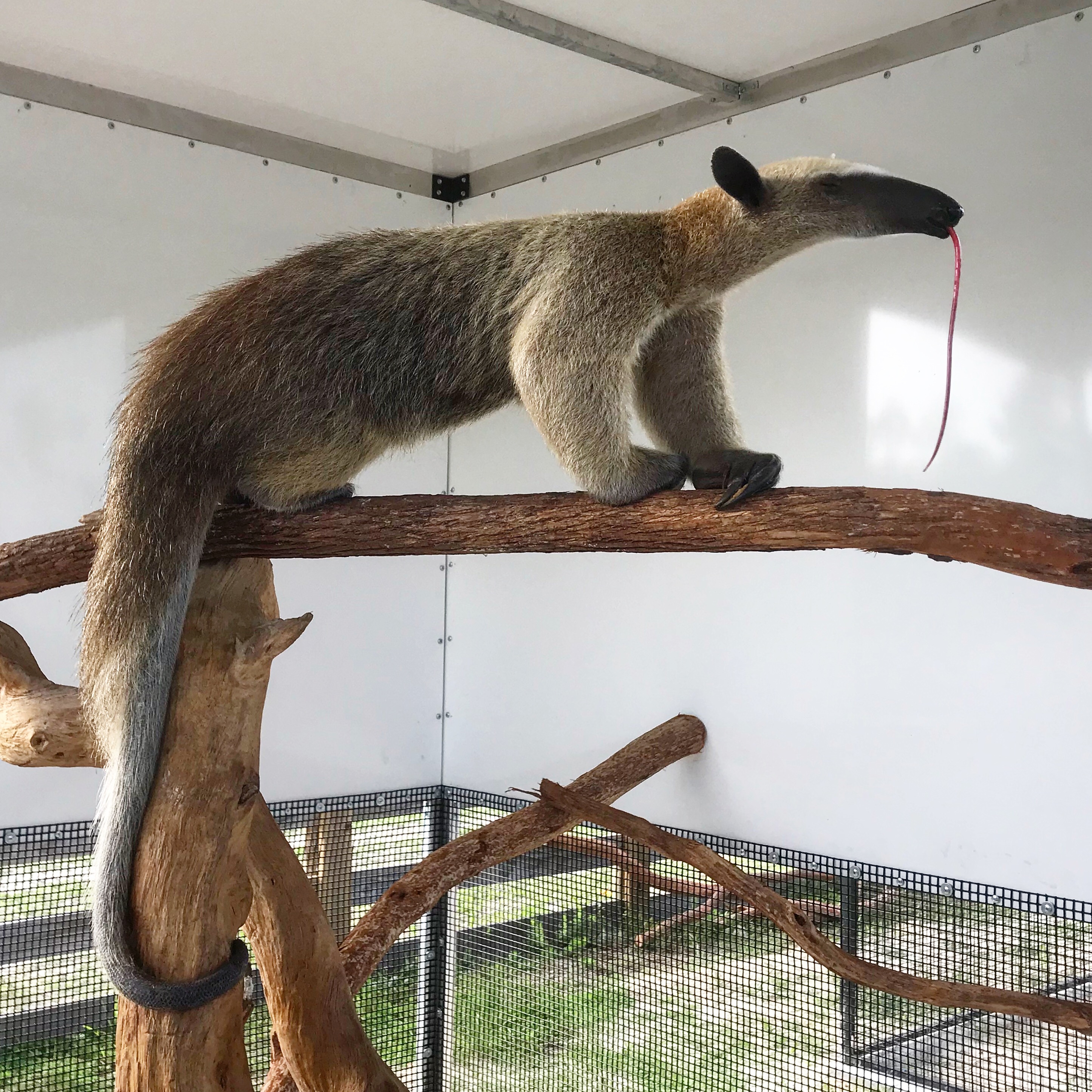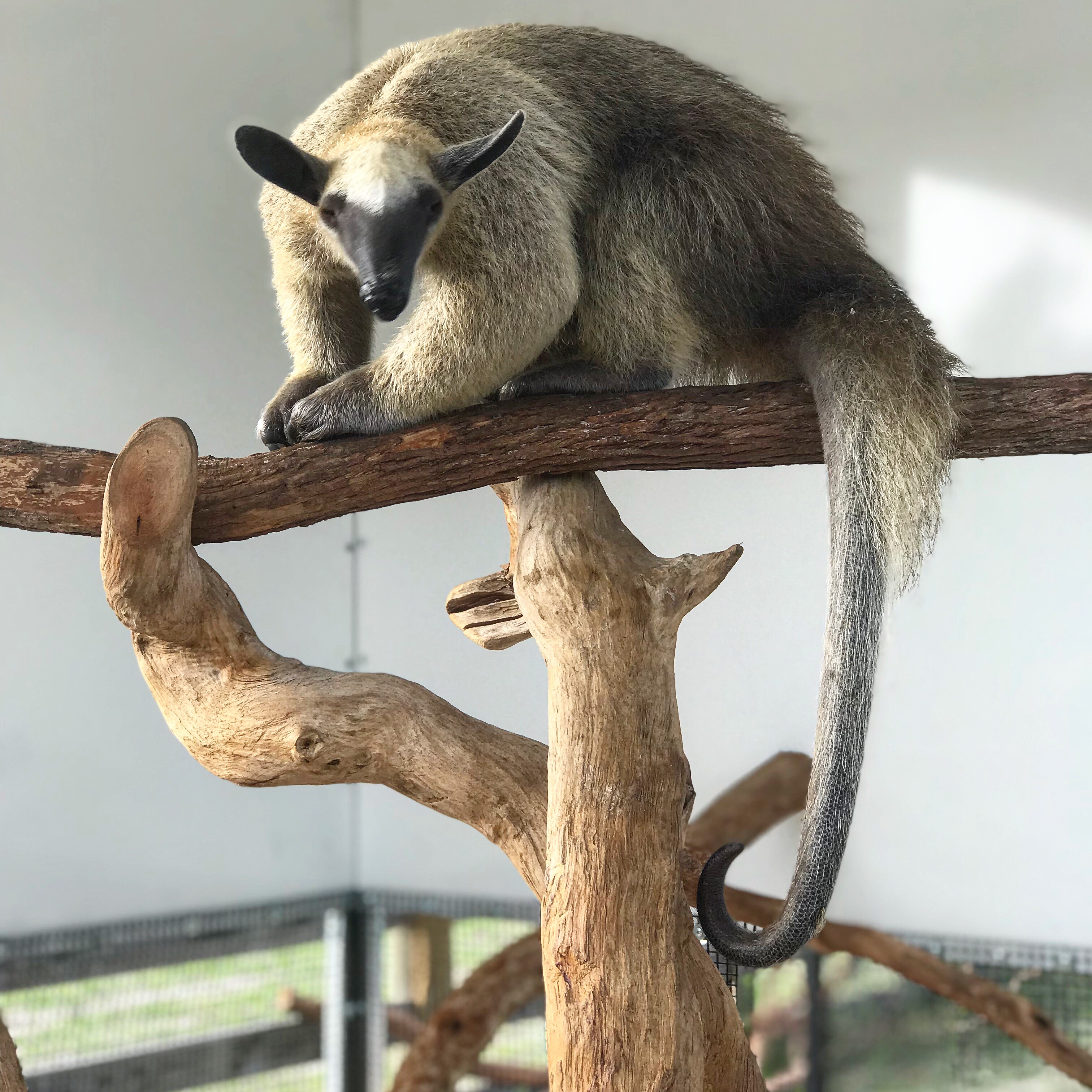Annabelle is a 10 month old female Southern Tamandua.


Tamanduas, and all anteaters, belong to the suborder Vermilingua, which literally means “worm-tongue,” describing their famous long tongues which can be almost 16 inches in length! These arboreal animals spend half their life in trees and half on the ground. Tamanduas, and all anteaters, have no teeth. In fact, their mouth can only open to the diameter of a pencil!
Southern Tamanduas are native to South America. These interesting creatures are at home both on the ground and in trees. In the wild they are most active at night, however they can be either nocturnal or diurnal in nature. Annabelle has shown a preference to being nocturnal and she is most active after sunset.
The longest captive southern tamandua was known to live for nine years and six months. In the wild they have been known to live up to sixteen years.
Southern Tamanduas have a thick coarse coat to protect them from ant bites. Their coat can be a light gold or black and tan color.
The Southern Tamandua is a toothless mammal that is between 21 and 31.5 inches in length, with an additional 15 to 23 inch long prehensile tail that is strong enough to hold their entire body weight. This species typically weighs around 10 pounds. They have short muscular feet with five fingers consisting of large sharp claws that can grow up to 16 inches in length and are used to defend themselves. To avoid puncturing themselves with their sharp claws, they walk on the outside of their curved wrists.
Their prehensile tail is almost bare of fur, allowing it to grip tree branches easily. When walking on the ground they drag their tail behind them, as opposed to carrying it upright.
Southern tamanduas are between 21 and 31.5 inches in length, with an additional 15 to 23 inchlong prehensile tail. This species typically weighs around 10 pounds.
The word Tamandua means ‘insect eater’. So it’s not surprising that in the wild these curious creatures feed exclusively on termites and ants. With tongue movements as rapid as 150 times per minute they can quickly ingest their ants/termites along with their larvae and cocoons. Tamanduas can eat approximately 9,000 ants per day along with bees or honey that may also find. These smart and careful animals leave little or no permanent damage as they only spend short periods of time feeding at each nest, to avoid using up a food source, so that they are able to return at a later date. Wild Southern Tamanduas’ diets consist of 30-65% protein and 10-50% fat.
In captivity they eat special formulated liquid diets of fruit, meat, and insects.
The Southern Tamandua is usually a solitary species, except at birth. They are known to be territorial and generally only come together to mate.
Tamanduas use their sense of smell as their primary form of communication. They can produce an unpleasant odor from a secretion from their anal glands. These secretions help mark trees, paths, objects and advertise their presence, status, and territories.
Tamanduas use vocal communication primarily between mother and young or during fights. They may hiss, snort, roar and sniff. Roars are generally heard during fights. Baby tamanduas get their mother’s attention with the use of high-pitched grunting sounds.
Tamanduas have small eyes and poor vision but a strong sense of smell and hearing.
Pregnancy lasts between 130 and 150 days, after which a single offspring is generally born. Twin births can occur, but are less common. As with other species of anteater, mothers carry young tamanduas on their backs throughout the first months of life. Young tamanduas remain with their mother for about one year before reaching sexual maturity and heading off on their own.
Intervals between births in the wild can range from 2- 3 years, making the reproductive rate of Tamandua abysmally low. For this reason it is extremely difficult for Tamandua populations to recover from any form of hunting.
The name Tamandua comes from the combination of two Tupi Indian words: “Taa”, meaning ant, and “Mandeu”, meaning trap.
A specialized mouth and tongue let tamanduas eat up to 9,000 ants in a single day!